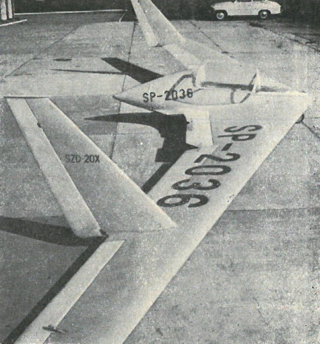
The Lo-100 is an aerobatic glider of classic wood and fabric construction well suited to amateur building methods. The designation Lo was bestowed by the designer Alfred Vogt in memory of his brother Lothar Vogt, with whom he had developed the predecessor model Lo-105 Zwergreiher. The first flight of the prototype took place in 1952 at the Klippeneck. An example is on display at the Gliding Heritage Centre.

The Antonov A-13 was a Soviet aerobatic sailplane flown in the 1950s and 1960s. It was a small, single-seat, all-metal aircraft developed from the A-11 which could optionally be fitted with that aircraft's longer-span wings. It was a mid-wing monoplane with a tadpole-like fuselage and a V-tail.
The Schneider ES-59 Arrow is a sailplane designed and manufactured in Adelaide, South Australia in the early 1960s. The Arrow was manufactured with a one-piece wing of 13.23 metres span. It was the first Australian-built sailplane to compete in the World Gliding Championships, 1963 in Argentina. The Arrow has wood/fabric wings and tail and a wood fuselage. It has a fixed main wheel and a nose skid.
The Fauvel AV.45 was an unorthodox motor glider produced in France in the 1960s and 1970s. Like other Charles Fauvel designs, it was a tailless aircraft, in this case inspired by the work that German firms had done on producing motorised versions of his AV.36 design. The prototype of the AV.45 was an extensively modified AV.36 powered by a Nelson H-59 two-stroke engine. AV.45s have been built with a number of other engines, however, including at least one aircraft powered by a small turbojet. Falconar marketed the plans in the 1970s.

The PIK-5 was a training glider produced in Finland in the 1940s, and 1950s, equipping the country's gliding clubs with an aircraft greater in performance than primary gliders but less than competition sailplanes.

The SZD-20x Wampir II was a single-seat tail-less research glider designed and built in Poland from 1959.

The Standard Austria was a single-seat aerobatic glider that was originally designed and built in Austria from 1959 but production was moved in 1962 to Schempp-Hirth in Germany.

The IS-4 Jastrząb was a single-seat aerobatic glider designed and built in Poland from 1949.

The Slingsby Type 45 Swallow was designed as a club sailplane of reasonable performance and price. One of the most successful of Slingsby's gliders in sales terms, over 100 had been built when production was ended by a 1968 factory fire.
The Civil Aviation Department RG-1 Rohini is an Indian two-seat training sailplane of the 1960s. A high-winged wooden monoplane, with side-by-side seating;at least 107 were built.

The Schreder Airmate HP-8 is an American, high-wing single seat glider that was designed by Richard Schreder after the loss of the HP-7 in 1957.

The Matteson M-1 was an American high-wing, single-seat, FAI Open Class glider that was designed and built by Fred Matteson of Palo Alto, California and Alfred Vogt of Schempp-Hirth.

The Hütter Hü 17, is a German high-wing, strut-braced, single-seat, utility training glider that was designed by brothers Ulrich Hütter and Wolfgang Hütter in the 1930s.
The Vogt Lo-150 is a West German high-wing, single seat glider that was designed by Alfred Vogt and produced by the Wolf Hirth Company.

The Lehtovaara PIK-16 Vasama is a Finnish mid-wing, single-seat, FAI Standard Class glider that was designed by Tuomo Tervo, Jorma Jalkanen and Kurt Hedstrom, who were students at the Polyteknikkojen Ilmailukerho (PIK) and produced by Lehtovaara.

The Antonov A-15 is a Soviet mid-wing, V-tailed single-seat, FAI Open Class glider that was designed by Oleg Antonov and produced by Antonov.

The Wassmer WA-30 Bijave is a French two-seat advanced training glider designed and built by Wassmer Aviation of Issoire.
The Kometa-Standard was a Standard Class glider, designed and built in Bulgaria in the early 1960s. Thirty were flown by local gliding clubs.
The UTG-1 Loudon was an intermediate glider designed and built at the University of Toronto in Canada during the late 1940s.
The IS-4 was a high performance glider designed by Iosif Şilimon and built in Romania in the late 1950s at the URMV-3 factory at Braşov.













